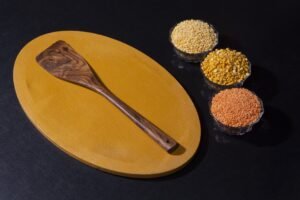Wooden Spoons
Handcrafted Wooden Kitchen Utensils with Round and Square Holders for Healthy Cooking
Handcrafting wooden utensils involves a number of steps and can require a range of skills, depending on the specific design of the utensils. Here are some of the key steps involved in the process:
Selecting the wood: The first step in handcrafting wooden utensils is to select the type of wood that will be used. Different woods have different characteristics, such as strength, weight, and color, so it’s important to choose the right wood for the specific type of utensil you want to make. Common woods used for utensils include maple, cherry, and walnut.

Cutting and shaping the wood
Once the wood has been selected, it must be cut and shaped into the desired shape of the utensil. This may involve using a saw, chisels, and other hand tools to cut the wood into the appropriate shape and size. The wood may also be sanded and smoothed to remove any rough edges or imperfections.
Joining the pieces
If the utensil is made up of multiple pieces, such as a wooden spoon with a handle and a bowl, the pieces must be joined together. This may involve using wood glue, nails, or other fasteners to securely attach the pieces. The joints must be carefully aligned and reinforced to ensure that the utensil is strong and durable.
Finishing the utensil
Once the utensil has been shaped and assembled, it must be finished to protect the wood and enhance its appearance. This may involve applying a sealant or wood finish, such as varnish or oil, to the surface of the utensil. The finish may also be buffed and polished to give the utensil a smooth, shiny appearance.
Overall, handcrafting wooden utensils requires a combination of woodworking skills and attention to detail. The process can be time-consuming and requires a lot of care and precision to produce high-quality utensils that are both functional and beautiful.

Rosewood made Wood Utensils
Rosewood is a type of wood that is commonly used in furniture and woodworking. It is prized for its beautiful color and grain, as well as its durability and resistance to rot. Here are some of the key benefits of rosewood:
1. Beautiful appearance
One of the most notable benefits of rosewood is its beautiful appearance. The wood has a rich, reddish-brown color that deepens with age, and it has a distinctive grain pattern that adds visual interest to any piece of furniture or woodwork.
2. Durability
Rosewood is known for its durability and resistance to rot and decay. This makes it a popular choice for furniture and other woodworking projects that will be exposed to the elements or used heavily.
3. Easy to work with
Rosewood is relatively easy to work with, compared to other types of wood. It can be carved, shaped, and sanded into a wide range of forms and shapes, which makes it a versatile material for woodworkers.
4. Naturally insect-resistant
Rosewood is naturally insect-resistant, which makes it less likely to be damaged by wood-boring insects such as termites and beetles. This can help to extend the lifespan of rosewood furniture and other woodworking projects.
5. Sustainable
Despite its popularity, rosewood is a relatively sustainable resource. Many species of rosewood are not endangered, and the wood is often harvested from managed forests, where it is replanted and allowed to grow back. This helps to ensure that rosewood will continue to be available for future generations of woodworkers.

